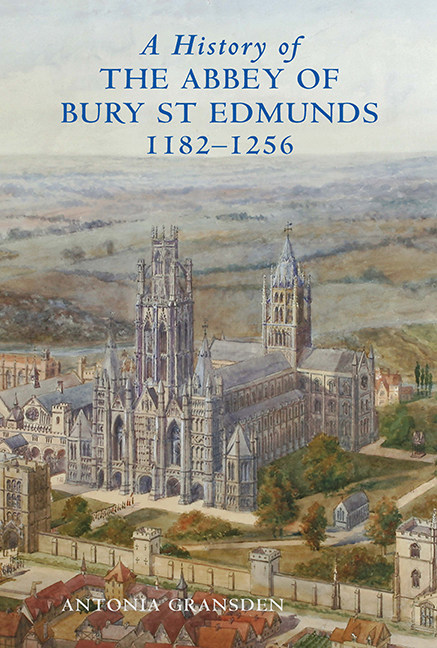Book contents
- Frontmatter
- Dedication
- Contents
- List of plates
- List of figures
- Preface
- Editorial Note
- Epigraph
- Acknowledgements
- Maps and plans (figures 1–9)
- Part I Samson of Tottington, Abbot 1182–1211
- 1 Samson's biographer, Jocelin of Brackland (de Brakelond), and his work
- 2 Samson's early life and career
- 3 Samson's election to the abbacy
- 4 The early years of Samson's abbacy and reform of estate management
- 5 Conflict with the convent
- 6 Relations with the town of Bury St Edmunds
- 7 Samson and secular law
- 8 Samson and the knights of St Edmund
- 9 Relations with the Angevin kings
- 10 Samson and the papacy
- 11 Samson as a builder
- 12 Religious and intellectual life under Samson
- 13 Samson's death and burial
- PART II The Abbey 1212–1256
- APPENDICES
1 - Samson's biographer, Jocelin of Brackland (de Brakelond), and his work
from Part I - Samson of Tottington, Abbot 1182–1211
Published online by Cambridge University Press: 29 April 2017
- Frontmatter
- Dedication
- Contents
- List of plates
- List of figures
- Preface
- Editorial Note
- Epigraph
- Acknowledgements
- Maps and plans (figures 1–9)
- Part I Samson of Tottington, Abbot 1182–1211
- 1 Samson's biographer, Jocelin of Brackland (de Brakelond), and his work
- 2 Samson's early life and career
- 3 Samson's election to the abbacy
- 4 The early years of Samson's abbacy and reform of estate management
- 5 Conflict with the convent
- 6 Relations with the town of Bury St Edmunds
- 7 Samson and secular law
- 8 Samson and the knights of St Edmund
- 9 Relations with the Angevin kings
- 10 Samson and the papacy
- 11 Samson as a builder
- 12 Religious and intellectual life under Samson
- 13 Samson's death and burial
- PART II The Abbey 1212–1256
- APPENDICES
Summary
Jocelin's toponymic indicates that he was a native of Long Brackland Street or Short Brackland Street in Bury St Edmunds. He reveals in the chronicle that he entered St Edmund's abbey in 1173, when Hugh I was abbot (1157–80), and that Samson was his master during his novitiate. Later he became the prior's chaplain and within four months of Samson's succession to the abbacy he was appointed his chaplain. He held that office for six years, acting as Samson's secretary, ‘noting many things and storing them in [his] memory’. After 1188 he seems to have had no official position in the abbey until he was appointed guest-master. The date of his appointment is unknown, but it must have been in 1197 or shortly afterwards. It is also unknown how long he held that office and so is the date of his death. The chronicle itself ends in 1202, with Samson's departure to visit King John in France on the convent's business. This is all that can be learnt about Jocelin's career from the chronicle. However, some scholars have identified him with ‘Jocelin the almoner’ who occurs as a witness in a charter, datable to between 1206 and 1209, and in the account of the election, 1213– 15, of Samson's successor to the abbacy, Hugh of Northwold. This identification entails accepting that the story in the chronicle concerning Henry of Essex, recounted to the writer by ‘Jocelin, the almoner, a man of great piety, powerful in word and deed’, is an interpolation. This is quite possible: it certainly reads like one. Moreover, the description of Jocelin the almoner would fit Jocelin of Brackland nicely. Other scholars have argued that Jocelin was cellarer in the late twelfth and early thirteenth century. In its present form the chronicle was composed in 1202 or 1203. Jocelin, therefore, wrote retrospectively. He used written sources as well as oral testimony and his own recollections. He also worked up some notes or a draft memoir written when he was Samson's chaplain. This must explain the intimate, personal tone of the chronicle.
Jocelin was much more self-revelatory than most medieval biographers and chroniclers. Judging from his chronicle Jocelin was a pious and a good man. He obviously had a deep veneration for the abbey's patron saint, St Edmund.
- Type
- Chapter
- Information
- A History of the Abbey of Bury St Edmunds, 1182–1256Samson of Tottington to Edmund of Walpole, pp. 5 - 11Publisher: Boydell & BrewerPrint publication year: 2007



